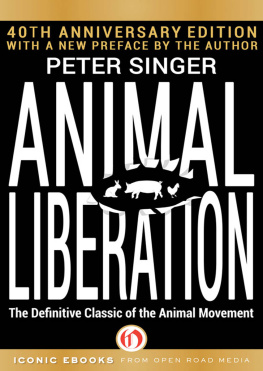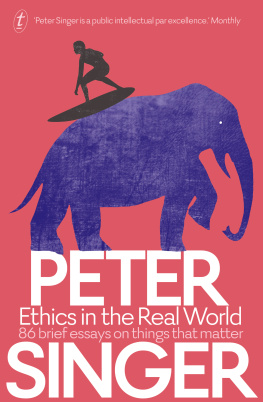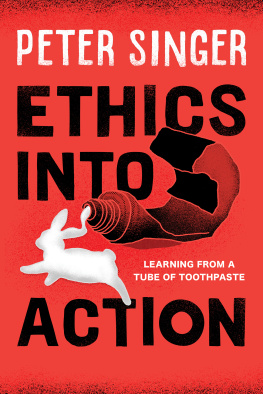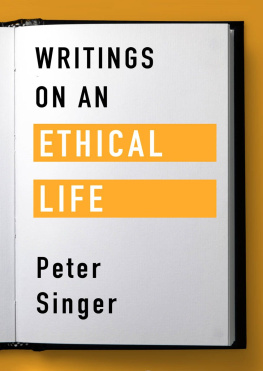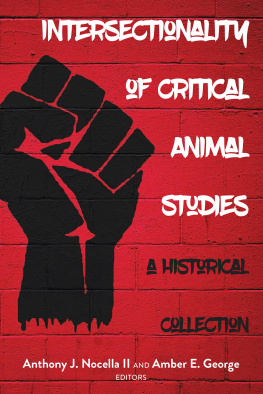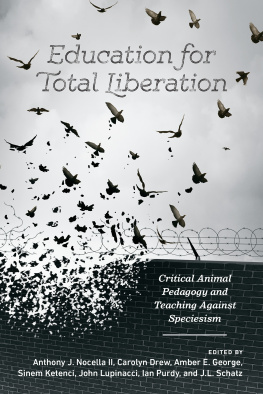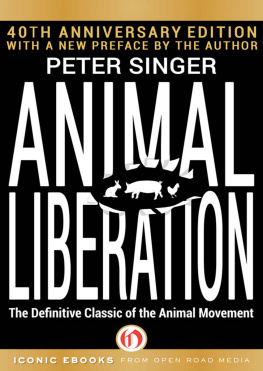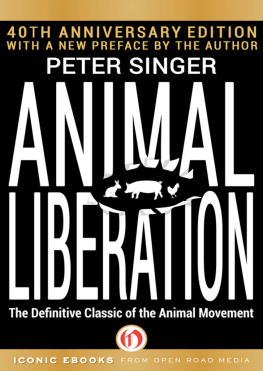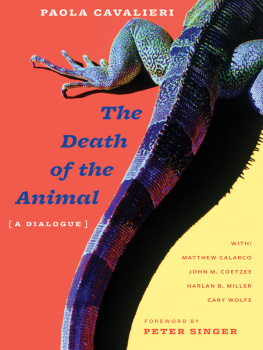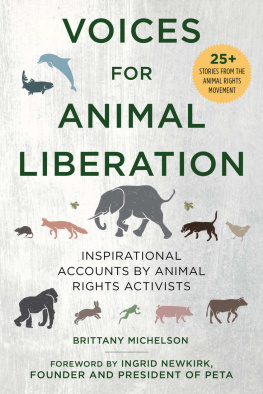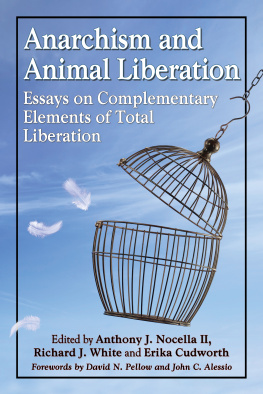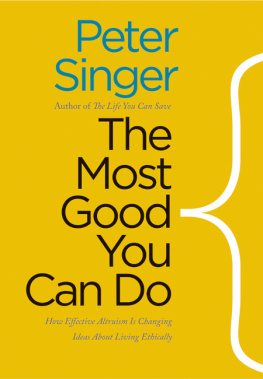Peter Singer - Animal Liberation: The Definitive Classic of the Animal Movement
Here you can read online Peter Singer - Animal Liberation: The Definitive Classic of the Animal Movement full text of the book (entire story) in english for free. Download pdf and epub, get meaning, cover and reviews about this ebook. year: 2015, publisher: Open Road Media, genre: Romance novel. Description of the work, (preface) as well as reviews are available. Best literature library LitArk.com created for fans of good reading and offers a wide selection of genres:
Romance novel
Science fiction
Adventure
Detective
Science
History
Home and family
Prose
Art
Politics
Computer
Non-fiction
Religion
Business
Children
Humor
Choose a favorite category and find really read worthwhile books. Enjoy immersion in the world of imagination, feel the emotions of the characters or learn something new for yourself, make an fascinating discovery.
- Book:Animal Liberation: The Definitive Classic of the Animal Movement
- Author:
- Publisher:Open Road Media
- Genre:
- Year:2015
- Rating:5 / 5
- Favourites:Add to favourites
- Your mark:
- 100
- 1
- 2
- 3
- 4
- 5
Animal Liberation: The Definitive Classic of the Animal Movement: summary, description and annotation
We offer to read an annotation, description, summary or preface (depends on what the author of the book "Animal Liberation: The Definitive Classic of the Animal Movement" wrote himself). If you haven't found the necessary information about the book — write in the comments, we will try to find it.
Animal Liberation: The Definitive Classic of the Animal Movement — read online for free the complete book (whole text) full work
Below is the text of the book, divided by pages. System saving the place of the last page read, allows you to conveniently read the book "Animal Liberation: The Definitive Classic of the Animal Movement" online for free, without having to search again every time where you left off. Put a bookmark, and you can go to the page where you finished reading at any time.
Font size:
Interval:
Bookmark:

Animal Liberation
The Definitive Classic of the Animal Movement
Peter Singer

To Richard and Mary, and Ros and Stan, andespecially toRenata
This revised edition is also for all of you who have changed your lives in order to bring Animal Liberation closer. You have made it possible to believe that the power of ethical reasoning can prevail over the self-interest of our species.
Preface to the 2009 Edition
In 2008, tens of millions of Americans watched with horror and disbelief when they saw on their evening news an undercover video of cattle too sick to walk being kicked, shocked with electric prods, jabbed in the eye with a baton, and pushed around with a forklift, all so that they could be driven near enough to the kill box to be slaughtered and processed into meat. The video was taken at the Westland/Hallmark slaughterhouse, in Chino, Californiaa large, supposedly state-of-the-art operation and a major supplier to the National School Lunch Program, located not in a rural backwater but just thirty miles from the heart of Los Angeles. Because eating meat from cows that cannot walk is a health hazard, the video led to the largest meat recall in the history of the United States.
The revelations provided dramatic confirmation of the thesis of this book. After pleading guilty to charges of animal cruelty, Daniel Ugarte Navarro, the pen manager shown giving sick cows electric shocks in the face, beating them, and using a forklift to move them, said that he had done nothing wrong and was just doing his job. Its an excuse we have heard before, but not without a grain of uncomfortable truth. Despicable as Ugartes actions were, there is something more fundamentally wrong with the ethics, and the law, governing how we treat animals. If people want to eat sentient creatures and there is competition to provide meat at the lowest possible price, then the system will reward those who meet this demand. In that sense, Ugarte was just doing his job. But for the bad luckfor him and for Westland/Hallmarkthat an investigator from the Humane Society of the United States was secretly filming his actions, Ugarte would have continued effectively maximizing the profits of his employer.
The widespread revulsion evoked by this and other undercover videos of animal abuse suggests that it is ignorance, rather than indifference to animals, that keeps massive, institutional cruelty to animals in place in the U.S. Now that the media are taking animal issues more seriously, this ignorance is starting to break down. But it has been a long struggle to get to this point. Since this book was first published, in 1975, the hard work of countless animal activists has paid off, not only in greater public awareness of animal abuse, but also in concrete benefits for animals. In the 1980s, under pressure from the animal movement, cosmetics corporations began putting money into finding alternatives to testing on animals. The development of product testing methods not involving animals now has a momentum of its own in the scientific community and is partly responsible for holding down the number of animals used. Despite fur is back claims by the industry, fur sales have still not recovered to the level they were at in the 1980s, when the animal movement began to target it. Companion animal owners have become better educated and more responsible, and the number of unwanted and stray animals killed in shelters and pounds, though still far too high, is down dramatically.
The vast majority of animals abused by humans, however, are farm animals. Whereas the number of animals used in research in the United States is, at about twenty-five million, roughly equal to the population of Texas, the number of birds and mammals killed for food each yearagain, in the U.S. aloneis around ten billion, or one and a half times the population of the world. (That number does not include fish or other aquatic animals.) Since most of these animals are raised in factory farms, their suffering lasts their entire lives.
The first breakthrough for farm animals came in Europe. In Switzerland, the battery cage system of producing eggs described in Chapter 3 became illegal at the end of 1991. Instead of cramming their hens into small wire cages too small for the birds to spread their wings, Swiss egg producers moved the birds to sheds where they could scratch on a floor covered with straw or other organic material and lay their eggs in a sheltered, soft-floored nesting box. Once the Swiss had shown that change is possible, opposition to battery cages mounted throughout Europe, and the European Union, covering twenty-seven member states and almost 500 million people, has now agreed to phase out the standard bare wire cage by 2012, giving hens more room, access to a perch, and a nesting box to lay their eggs in.
Further steps followed, all with widespread public support and the backing of the European Unions leading scientific and veterinary experts. As the following pages show, intensively raised veal calves, deliberately kept anemic, deprived of straw for bedding, and confined in individual crates so narrow that they cannot even turn around, are among the most miserable of all farm animals. That system of keeping calves had already been banned in Britain when I revised the text of this book for the 1990 edition (which remains the text that follows this preface). Today, veal crates are banned, not just in Britain, but throughout the European Union. Matters have also improved for the pig industrys breeder sows. Confining pregnant sows in individual crates was banned in Britain in 1998, and will be prohibited in Europe from 2013, except during the first four weeks of the sows pregnancy.
When Europe was debating and legislating these changes, there seemed no prospect of any similar laws getting through the U.S. Congress, or indeed anywhere else in the U.S. The first sign of change was a 2002 initiative by animal welfare groups that put a proposition on the ballot in Florida to ban crates for pregnant sows. Florida is far from the most progressive state in the country for animal welfare issues, but the proposal passed with a clear majority. Four years later, the same issue came up in Arizona, where a ban on veal crates was added to the proposal as well. Again, the voters approved the measure by a solid margin.
The Arizona result sent a signal to producers. Just one month later, the two largest producers of veal in the U.S. promised to get rid of veal crates within two to three years. Then the largest pig producers in the U.S. and Canada announced that they would, over the next ten years, phase out sow crates. Explaining this move, the U.S. producer, Smithfield, mentioned the views of its customers, of whom McDonalds is among the largest. McDonalds, which welcomed the decision, had for many years been in discussion with animal activists about reducing the suffering of the animals from which its products come. Other big pork producers soon followed. In 2007, Oregon became the first state to legislate to ban sow crates rather than have the issue put to a popular vote, and the following year, Colorado legislated to ban both sow and veal crates. After decades of resisting criticism of individual crates for veal calves, the American Veal Association resolved to recommend that its members convert to more welfare-friendly group housing by 2017.
Many notable U.S. chefs, food retailers, and caterers are likewise moving away from the worst forms of animal confinement. Wolfgang Puck is ending his use of pork from sows kept in crates, as well as his use of eggs from caged hens. Major chains including Burger King, Hardees, and Carls Jr. have started buying pork and eggs from producers who avoid sow crates and battery cages. Hundreds of campuses across the United States are now avoiding eggs from hens kept in cages, and in 2007 Compass Group, the worlds largest food service provider, announced that in the future all its whole eggs would come from producers who do not use cages.
Font size:
Interval:
Bookmark:
Similar books «Animal Liberation: The Definitive Classic of the Animal Movement»
Look at similar books to Animal Liberation: The Definitive Classic of the Animal Movement. We have selected literature similar in name and meaning in the hope of providing readers with more options to find new, interesting, not yet read works.
Discussion, reviews of the book Animal Liberation: The Definitive Classic of the Animal Movement and just readers' own opinions. Leave your comments, write what you think about the work, its meaning or the main characters. Specify what exactly you liked and what you didn't like, and why you think so.

